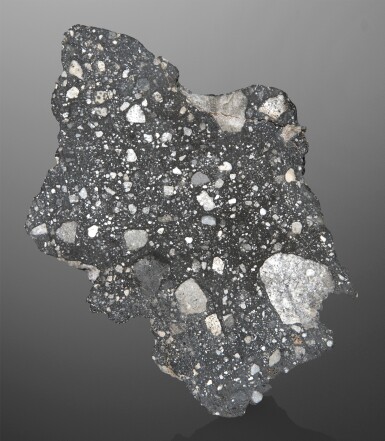Natural History
Natural History

Lunar Meteorite | End Piece Of The Quintessential Lunar Breccia, Rabt Sbayta 002
No reserve
Lot Closed
December 3, 09:04 PM GMT
Estimate
14,000 - 20,000 USD
Lot Details
Description
Lunar Meteorite — End Piece Of The Quintessential Lunar Breccia, Rabt Sbayta 002
The Moon – Lunar meteorite (feldspathic breccia)
Rio de Oro, Western Sahara (24.241°N, 14.701°W)
107 x 75 x 25mm (4.25 x 3 x 1 in.) and 141.3 grams
This is an end-piece of a lunar meteorite — a piece of the Moon ejected off the lunar surface following an asteroid impact which landed on Earth and subsequently cut to reveal its interior. Less than 775 kilograms of lunar meteorites are known to exist and a significant fraction is in museums and research institutions. Most of the Moon’s craters are the result of such impacts. Lunar specimens are identified by specific geological, mineralogical, chemical and radiation signatures. Many of the common minerals found on Earth’s surface are rare on the Moon; in addition, lunar rocks contain gases originating from the solar wind with isotope ratios that are very different than the same gases found on Earth. Some lunar samples returned to Earth by the Apollo mission astronauts are closely similar to suspected lunar meteorites — and this is one such example. The cut face of this choice example reveals abundant signature anorthosite suspended in lunar regolith (lunar soil that in this instance experienced melting). The largest clast reveals a small galaxy of other inclusions, which evidences the repeated bombardment of the Moon. The textured convex exterior surface contains a mottling of hues ranging from gray to graphite that is embellished with a natural desert varnish. Among the rarest substances on Earth, this lunar sample was classified by Dr. Anthony Irving, one of the world’s foremost classifiers of planetary material.
The official classification of this lunar meteorite appears in the 106th edition of the Meteoritical Bulletin. A copy of the abstract accompanies this offering.
PROVENANCE:
The main mass of this meteorite is on display at the Maine Mineral & Gem Museum, home to the largest specimen of the Moon on Earth
